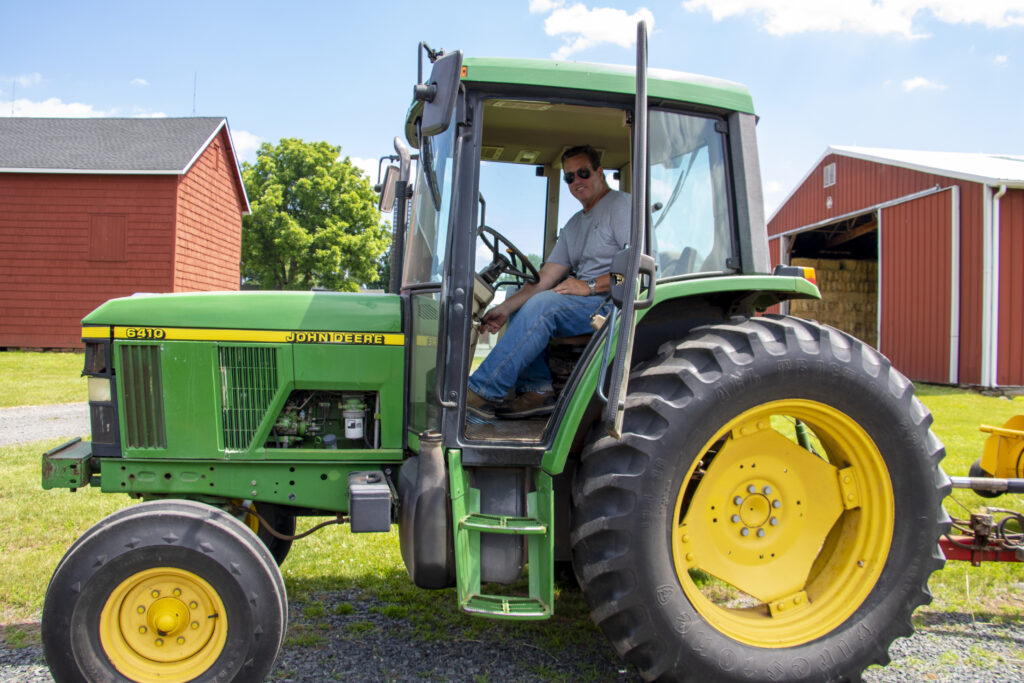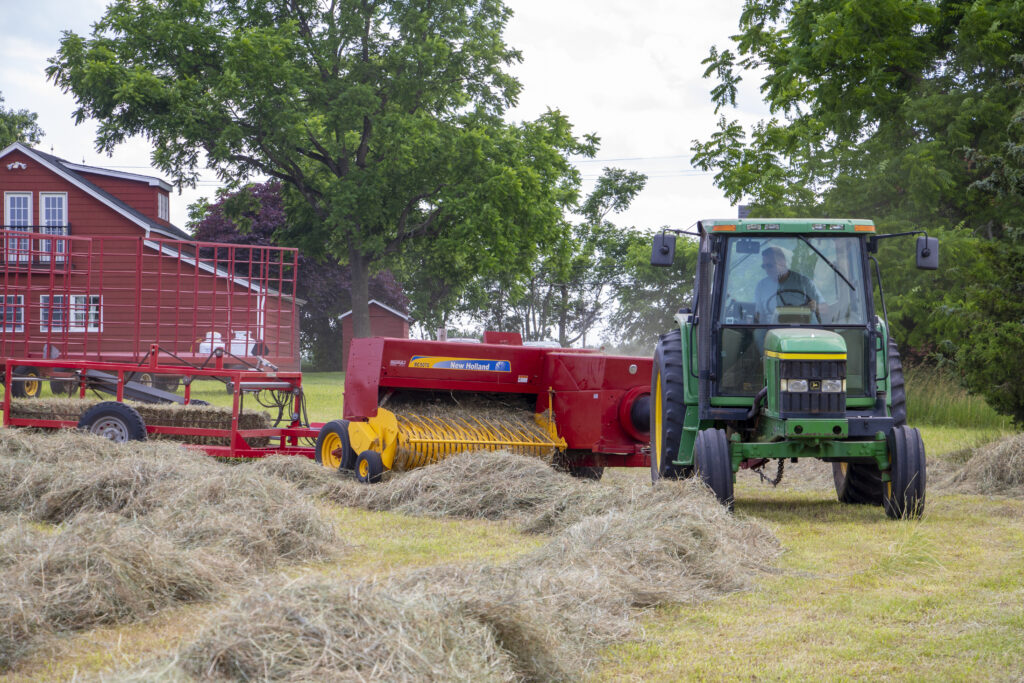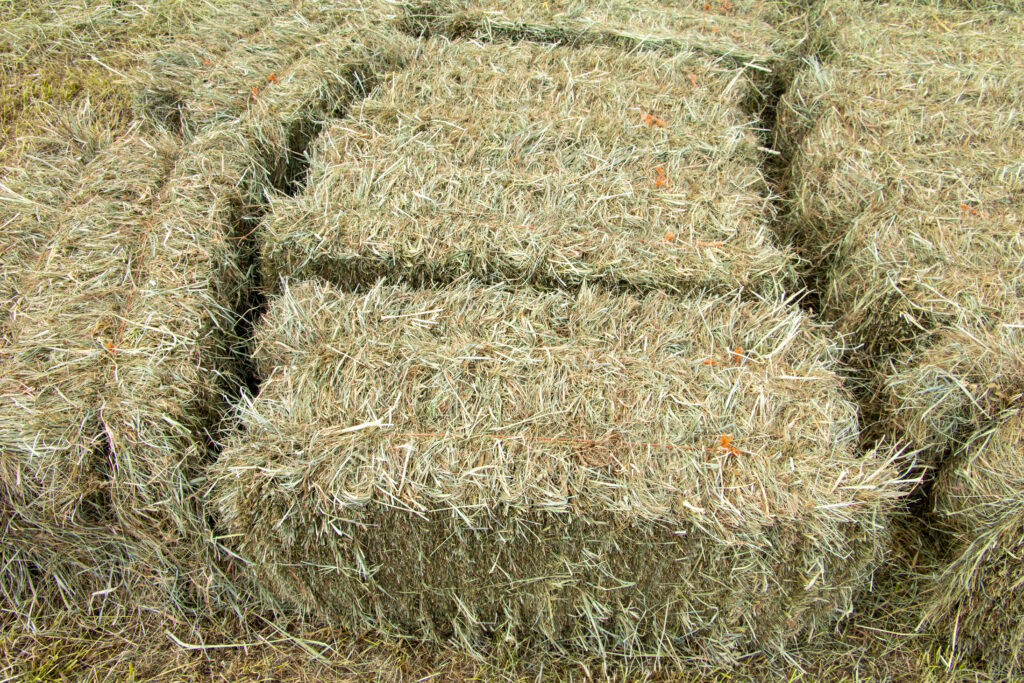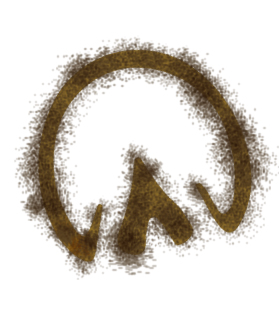Career: Hay Producer
Hay Everyone!
I know it’s been a while, but I’m excited to be bringing you the latest post in my careers in the equine industry series! This is one of my favorite series to revisit because I get to learn so much about the equine industry and the people who work in it. I’m especially excited for this week’s dive into the life of a hay producer because we get to talk about one of my favorite things – hay!! This week I interviewed Mr. Ryck Suydam, a hay producer and farmer in Somerset County, New Jersey.
Keep reading to hear more from Mr. Suydam!
Lord Nelson (LN): What does your typical day at work look like?
Mr. Suydam (Mr. S): It varies depending on the time of year. We’re sitting here in June which is prime time hay season. I got up around 5:15AM to take care of animals and get things started. I had to deliver a load of hay this morning, so I got that done around 8:30. Then I prep all the machinery to get out to the field. I rake the hay around 11:30 and then I go out to bale in the afternoon. I have some friends who will show up after they get done with their work and help me finish baling. That is a very typical day during the hay season. For us, hay season typically starts the end of May when we’re making long straw, in June we’re finishing up the Orchard grass and timothy, and then we get into brome, which is most of what we have. Then we’ll do wheat straw, so this typical day will remain the same through the end of July. August gets a little easier. That’s when we catch up on stuff that we haven’t done like paint barns and fix stuff we’ve put aside, but come September it will be second cutting on these hay fields and then that same day starts all over again. Once the frost hits, we’re done in the fields. That’s when everyone’s pastures are done and they need hay, so they’re either coming to me or I’m delivering. My hours shrink a little bit with the daylight. It gives me time to do other things. For most farmers, December, January, and February is when we get to go to conferences and learn to be better at what we’re doing. Then we ramp it right back up again in, hopefully, the first of April with soils and stuff like that.

Mr. Suydam preparing for an afternoon of baling hay.
LN: What is your primary client base and how do they get their hay?
Mr. S: Our focus is on making hay for horses. A little bit goes for sheep and goats, but most of it goes to horses. I encourage people to come here because it’s a whole lot easier to manage. I would say about 80% of customers are coming here to pick up their hay. Some people drop off their trailers. I fill them and then they come back to get them. That’s wonderful because then I can fit it into my schedule. We’ll do deliveries for those who can’t get here, and they pay a fee for that. Fuel, time, people. These things cost money. I’m a nice guy, but I’ve got to make money at the end of the day.
LN: How does making a profit play into sustainability?
Mr. S: I’m glad you brought this up. Sustainability is this phrase in agriculture of “’Oh it’s got to be sustainable this and sustainable that, the soil, the water, the air”. Yes, and I’m a big fan of clean air, clean water, clean soil and these have to be sustainable; but if you can’t make money on it, it’s not sustainable. People forget that. Sustainability got hijacked and everyone’s talking about soil, water, air. That’s great, but unless you can make money at it, it’s not sustainable.
LN: What is your favorite part of the job?
Mr. S: I like cutting a field. You get to see every square inch of the field, what your plant population is like, if you’ve got any weeds. I like cutting because you can also judge the weight of the field. I’ll be honest. I was raking hay this morning, listening to music, blue sky, and the warm breeze. It’s an open tractor, but it feels good. I love that and that’s when you really start to smell it. Henry David Thoreau said “the smell of the hay is the perfume of the harvest” and I think about that all the time. Especially when you finish filling a barn and then you walk into it and that smell hits you. I love that part too. I like working in the field a whole lot more than I like working with the people! Cutting hay, raking hay, even baling hay as long as things don’t break, are my favorite parts of this job.

Mr. Suydam out in the field doing what he loves.
LN: What is your least favorite part of the job?
Mr. S: My least favorite part of this job is writing the checks. My fertilizer bill this year tripled. That wasn’t fun. I guess getting the weather wrong is also not great. I don’t like that part. When I’m throwing hay and it’s 10 degrees and brutally cold and a biting wind, that’s part of the deal, but it doesn’t mean it’s fun.
I used to be able to throw and stack every bale made on this farm. I’ve gotten a little older and I can’t do it quite as well as I used to. That’s maybe disappointing. I’ve purchased enough machinery now that I don’t have to throw it all.
LN: If someone were considering a similar career path, what advice would you offer to them?
Mr. S: You’ve got to know your demographics, your neighborhood. We’re sitting right now in Somerset County and if you go up to Basking Ridge, Bedminster it’s huge horse country. Right where we are, not so much. On the other side of the highway is Middlesex County. There’s plenty of horses in Middlesex County. That’s where most of my hay goes. You’ve got to know where your market is. Whatever business you’re in, know what your market is. Transportation of hay is not easy. It’s big and bulky. That’s the first thing. And then diversify a little bit. Don’t put all your eggs in one basket or any other phrase. You’ve got to diversify your crop a little whether it’s different varieties of hay or something else. In my case, it’s three types of hay and two types of straw. This farm has evolved over time. I don’t do greenhouse stuff anymore, but we’ve done pumpkins, we’ve done Christmas trees at the same time as we’re doing hay. Always keeping in mind diversify because if you have a bad hay year and there’s no revenue, that’s not good. A little diversification is a good thing. Keep your eyes open for these other opportunities. I work some other crops and have a little bit of livestock. It’s kind of nice because when I get a couple of broken bales and wonder what to do with them. Well, I can just throw them to the sheep.
LN: What is your most memorable or favorite memory from your career?
Mr. S: It would probably be working four generations together. That was cool. My grandfather, when my kids started working in the field, had pretty much been out of the picture. He would still show up in the field and give his advice as did my grandmother. She still worked in the field. She walked around with a pitchfork as we were baling and let you know when you missed this piece and missed that piece. It would be me, my dad, my three boys, always my grandmother, and sometimes my grandfather. That was cool. That doesn’t happen every day. There’s no business involved there or science. It’s just cool.
LN: What made you decide to pursue a career as a hay producer?
Mr. S: I was born here. I’ve had other careers. I was a partner in an insurance agency for thirty-eight years, so I sold a lot of insurance and managed a bunch of people. I’m the outgoing president of the New Jersey Farm Bureau. I’ve been the president for nine and half years. While all at the same time farming. I taught school for a little bit when I graduated because I needed the money. I’ve had multiple careers the whole time and now in a few days that will be the only thing I’m doing.
LN: How did you establish yourself within this field?
Mr. C: I always wanted to farm, but not just farm. I had pretty good teachers and I got pretty good at this. I’ve striven to have the best soils, the best crop I can (if I judge the weather right), and always balance the fertilizer and how much yield I’m going to have. Time management is a huge part of farming. Again, you’re working with the weather, the sunlight, and whether or not people show up. Managing your time is one of the most critical things because when it’s ready you got to go. You can’t push the pause button and come back three days later and finish. You’ve got to go. I’m not shy. My product pretty much sells itself, but there are times when I would take samples and drop them off in a barn I didn’t know. I’d introduce myself, drop off a couple of bales, and let them know where we are, what we do, and how long we’ve been doing it. I give some referrals, if necessary. You’ve got to have some confidence. You’ve got to put yourself out there. Again, I had good teachers, so I got good at it and I told people.
LN: We often encourage horse owners to purchase their hay supply during hay season. Why do we do that and why is it important?
Mr. C: If you have the storage space, you can do that. This way you can guarantee your supply. My advantage is that I’ve got all of this storage space. I do and you don’t, so yes, it’s important to buy during the hay season. You can sometimes get it cheaper, if you get it out of the field and you’re guaranteeing your supply. Not everyone can do that. The unknown is “how many bales am I going to need?” And then “oh, look” I just got four more horses and what I thought I needed isn’t correct. There are a lot of producers like me that have the storage, so that if you can’t, you may pay a little bit of a premium later on, but you can get it. Building one of these steel barns has never been cheap and it’s more now than it’s ever been.

Fresh hay in the barn.
LN: Are there any last thoughts you’d like to leave our readers with?
Mr. C: If people want to do hay production, it’s a very local commodity. Grain is affected by markets and weather all over the world. Our biggest competition is Brazil when it comes to grain – corn, beans, wheat, sorghum. Even though I have a poor year with my soybeans, South America might have a great year and the price stays low. You’re working on a global economy. Hay you’re working on a local economy because you’re not shipping hay like you ship grain and hay isn’t sold on the Chicago board. If you have the horses in the neighborhood and you can put out a good product, you can get a good price for it. Someone might say “we ship hay to Florida” and yes, that does happen. That’s the exception. Most of them are people like me. The reason you’re shipping hay to Florida is because someone from New Jersey has their horse in Florida for the season and they want timothy. You can’t grow timothy in Florida, so now you’re shipping hay. That’s a slice of the business, but because it’s a local commodity it’s to my advantage. I can kind of set my price. Yes, people drive twenty or thirty miles to save a couple of bucks on a bale of hay, but you’re not going one hundred thirty miles. If you’ve got the ground, here’s another advantage to making hay. Wheat you have to replant every year. Corn, beans same thing. If you establish a good hay field, you’ve got five to thirty years. That means you’re not tilling the soil, you’re not burning fuel, you’re not releasing carbon, and you’re not buying seed. There’s less inputs than with some of the other crops. Bromegrass has held the best for us. It lasts forever. I’ve had some fields last thirty years. Timothy is usually more like five years and Orchardgrass is somewhere in between. If I don’t have to turn that soil over and replant it every year, that’s a win for me. That’s an advantage.
LN: Thanks for taking the time to chat with me and share your insights, Mr. Suydam! I might have to sample your product before I leave today!
Mr. C: It’s been my pleasure, Lord Nelson. I hope you enjoy your sample!

The fresh hay Lord Nelson sampled.
I think this might have been one of my favorite interviews! (I got to sample fresh hay, so you shouldn’t be surprised!) Hopefully, you’ve learned enough about life as a hay producer to either add it to your list of potential careers or remove it. I’m pretty sure I need to take it off my list because I would be too busy sampling everything to ever get any work done.
Until Next Time.
Your Friend,

Lord Nelson
